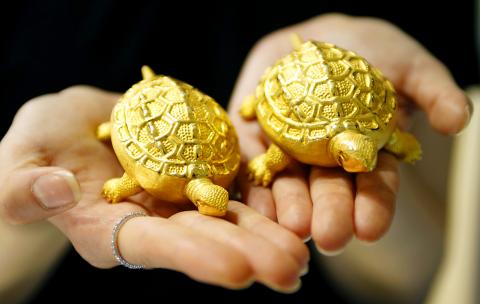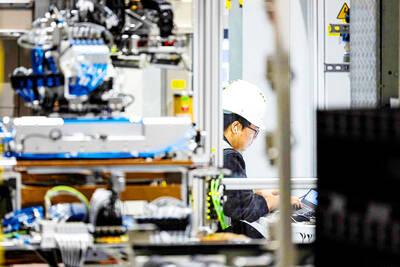South Korea spent more than US$1 billion in its first gold purchase in more than a decade, as uncertainty about global growth and sovereign debt push central banks around the world to diversify foreign reserves.
A brittle global economic recovery and precarious debt conditions in the US and Europe have boosted the safe-haven appeal of gold, lifting the bullion to a record high on Friday.
The Bank of Korea said in a statement yesterday it bought 25 tonnes of gold over the past two months, raising its gold holdings to 39.4 tonnes, news that helped lift spot gold by about US$6 from late Monday.

Photo: Reuters
Reserve currencies, like the US dollar and euro, “have been losing their clout since the recent global financial crisis partly due to abnormal monetary policy adopted in many countries and fiscal deficit problems,” said a central bank official who declined to be named because he was not authorized to speak to the media.
Data on 27 major economies from the Bank for International Settlements shows the US dollar’s inflation-adjusted real effective value has dropped by 10 percent in the past two years and the euro has lost 6 percent, reflecting the sharp increase in the amount of each currency in circulation.
South Korea’s gold holdings remain far smaller than that of other Asian central banks, with China, which ranks sixth globally, the biggest with 1,054.1 tonnes by the end of May, according to World Gold Council data.
Japan, No. 9 globally, has 765.2 tonnes of gold, or 3.3 percent of its total reserves, and 11th-ranked India has 557.7 tonnes, or 8.7 percent.
With prices hovering near historic highs, the central bank of Asia’s fourth-largest economy said gold looked less lucrative as an investment, but it was the right time to buy the precious metal because its foreign reserves had risen above US$300 billion.
The news helped boost gold prices, with spot up 0.4 percent at US$1,623.94 an ounce at 5:28am. Gold hit a record high of US$1,632.30 on Friday.
“Any news about central banks buying gold reassures consumers and other major players who are already looking at gold as an investment,” said Jeffrey Pritchard, an analyst at California-based commodities futures and options brokerage Altavest Worldwide Trading.
The increased gold holding would put South Korea in 45th position in the World Gold Council’s list of central banks holding gold, up from 56th previously, the Bank of Korea said.
The US has the biggest gold holding in its reserves, at 8,133.5 tonnes, or 74.7 percent of total reserves, according to the council’s report last month. Germany is a distant second with 3,401 tonnes, or 71.7 percent of its total reserves.

CHIP RACE: Three years of overbroad export controls drove foreign competitors to pursue their own AI chips, and ‘cost US taxpayers billions of dollars,’ Nvidia said China has figured out the US strategy for allowing it to buy Nvidia Corp’s H200s and is rejecting the artificial intelligence (AI) chip in favor of domestically developed semiconductors, White House AI adviser David Sacks said, citing news reports. US President Donald Trump on Monday said that he would allow shipments of Nvidia’s H200 chips to China, part of an administration effort backed by Sacks to challenge Chinese tech champions such as Huawei Technologies Co (華為) by bringing US competition to their home market. On Friday, Sacks signaled that he was uncertain about whether that approach would work. “They’re rejecting our chips,” Sacks

NATIONAL SECURITY: Intel’s testing of ACM tools despite US government control ‘highlights egregious gaps in US technology protection policies,’ a former official said Chipmaker Intel Corp has tested chipmaking tools this year from a toolmaker with deep roots in China and two overseas units that were targeted by US sanctions, according to two sources with direct knowledge of the matter. Intel, which fended off calls for its CEO’s resignation from US President Donald Trump in August over his alleged ties to China, got the tools from ACM Research Inc, a Fremont, California-based producer of chipmaking equipment. Two of ACM’s units, based in Shanghai and South Korea, were among a number of firms barred last year from receiving US technology over claims they have

It is challenging to build infrastructure in much of Europe. Constrained budgets and polarized politics tend to undermine long-term projects, forcing officials to react to emergencies rather than plan for the future. Not in Austria. Today, the country is to officially open its Koralmbahn tunnel, the 5.9 billion euro (US$6.9 billion) centerpiece of a groundbreaking new railway that will eventually run from Poland’s Baltic coast to the Adriatic Sea, transforming travel within Austria and positioning the Alpine nation at the forefront of logistics in Europe. “It is Austria’s biggest socio-economic experiment in over a century,” said Eric Kirschner, an economist at Graz-based Joanneum

France is developing domestic production of electric vehicle (EV) batteries with an eye on industrial independence, but Asian experts are proving key in launching operations. In the Verkor factory outside the northern city of Dunkirk, which was inaugurated on Thursday, foreign specialists, notably from South Korea and Malaysia, are training the local staff. Verkor is the third battery gigafactory to open in northern France in a region that has become known as “Battery Valley.” At the Automotive Energy Supply Corp (AESC) factory near the city of Douai, where production has been under way for several months, Chinese engineers and technicians supervise French recruits. “They